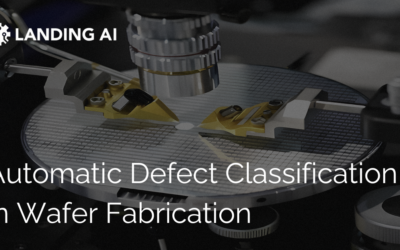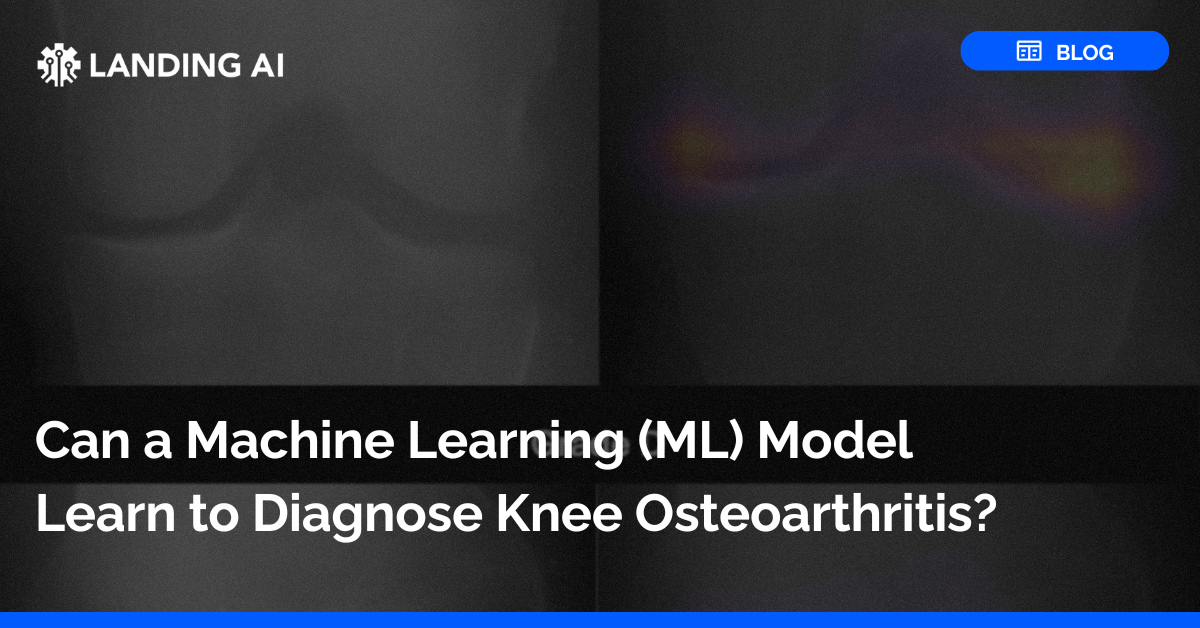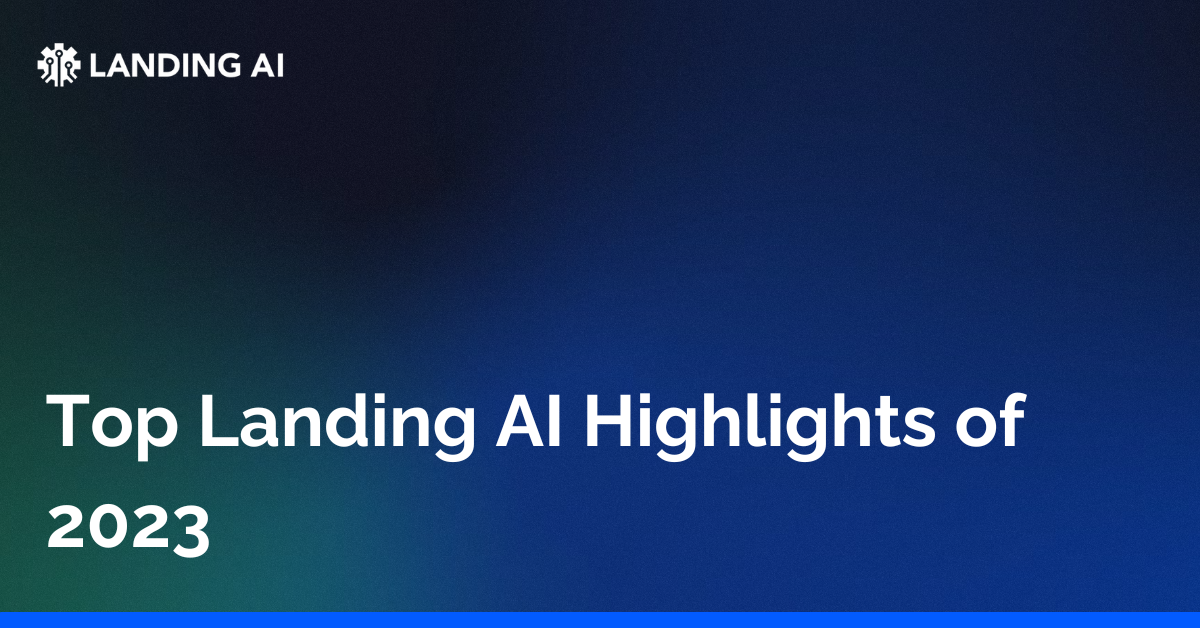It was another big year for Landing AI and our flagship product that makes computer vision projects possible for all—LandingLens. LandingLens makes it fast and easy for companies to create and test computer vision AI projects within minutes. No complex programming or AI experience is needed.
It’s been a revolutionary year for computer vision, according to our founder and CEO, Andrew Ng, with much more coming on the horizon. Let’s not get ahead of ourselves—first, let’s recap what we’ve done to upgrade LandingLens this year. In addition to product updates, Ng and the VP of Product, Kai Yang, made headlines by speaking about computer vision and Data-Centric AI. Let’s not forget the LandingLens community, which we’ll highlight in a moment.
Landing AI Product Updates
In February, we furthered the democratization of AI by ensuring anyone can sign up for LandingLens for free.
“Anyone can now create an AI model to process images. This has immediate applications in automotive, electronics, biotech, pharmaceutical, agriculture, and other industries. AI will create untold value for all industries and any company, with or without a machine learning team, can unlock the value of getting computers to see.” – Andrew Ng
We followed up by releasing Visual Prompting for LandingLens in April. This made it even easier to create computer vision apps. Developers can work even faster now. At that time, Ng told VentureBeat, “The GPT-3 moment — where prompting makes it easy to develop new applications — isn’t here yet for computer vision, but I believe visual prompts will get us closer.”
All areas of AI moved quickly in 2023. We kept the momentum going with the release of the world’s first validation-ready computer vision software for companies regulated by the Food and Drug Administration (FDA) in May.
The problem? Companies regulated by the FDA need to validate the tools that they use, everything from filling pill vials to manufacturing medical devices. This validation process can take months and require future updates as the tools change.
“We helped speed up the process for these types of companies with the validation-ready version of LandingLens. Now, they can streamline and speed up the validation process from three months to just one or two weeks, as well as improve reliability and quality by following a standard process.
In June, we released the Python Library. These updates to the Landing AI GitHub repository were made to help AI practitioners, whether seasoned or just starting out, unlock the potential of AI in their projects.
Another release came in August when we created the Landing AI Apps Space to enable rapid vision system development. This release made it possible for developers, data scientists, and AI novices to grab code to build customized solutions faster, including OCR systems. And we announced Docker deployment for LandingLens. With this latest release, DevOps users could integrate the model inference programmatically and scale deployments quickly both on-premise and in the cloud.
Finally, this month, we announced Domain-Specific Large Vision Models which enable enterprises to more quickly solve computer vision problems; Landing AI to help enterprises build and run LVMs at the edge, on-prem, and in the cloud
The releases of 2023 helped define a year of change as the general public became more interested in AI. Our focus remains on helping developers in AI industries like automotive, semiconductor, manufacturing, and food and beverage. There are also LandingLens use cases applicable to life sciences and retail. However, the mission of democratizing AI remains, which is why it’s free to sign up for LandingLens so that anyone can build a computer vision model in minutes.
Landing AI News Recap
As the world focused on AI, many began to question its safety as much as its possibilities. Ng shared this year that he does see AI having some risks.
“There is bias, fairness, concentration of power, amplifying toxic speech, generating toxic speech, job displacement. There are real risks,” he told Bloomberg Technology in May, via Business Insider.
When it comes to the state of AI, he shared during a seminar at Stanford that he sees supervised learning and generative AI as the two most important tools available today. He also talked about how these advances can speed up the work of developers—one of our goals at Landing AI.
Look for companies to go into 2024 with a more realistic approach to what it can do. Notably, Ng told the Wall Street Journal during the first week of 2023 that AI just cannot give you stock market predictions or use data to predict things that have yet to happen.
Our VP of Product, Kai Yang, shared about data-centric AI while at the EmTech Digital conference hosted by MIT Technology Review. “Instead of focusing on coding the right algorithm, data-centric AI is a systematic effort to get good data to train AI systems. This lets users who have solid domain knowledge prepare good data sets for the AI model to be trained on without having deep machine learning knowledge.”
Ng continued the conversation on data-centric AI with Fortune.
Now, something is “in the air” with computer vision, as Ng told Datanami. While, three years ago, he says it was a similar feeling to when NLP was that something. So what’s next for computer vision? “A revolution,” according to Ng. He says to look around the world at teams building upon vision transformers and you’ll see where things are headed.
Events Where We Met The Landing AI Community In 2023
We came together with you at more than a dozen events this year, and Landing AI team members like Andrew Ng, Dan Maloney, and Kai Yang also spoke at multiple events throughout the year.
-
-
- EmTech Digital
- Computex
- Automate
- CVPR and Computer Vision in the Wild workshop
- Snowflake Summit 2023
- VisionSpectra
- The Battery Show
- Seoul National University Data Science Day
- Operations Calling
- Digital Factory
- AI Hardware Summit
- CMTS
- ISPE
- TED AI 2023
- New York Tech Week
- FPT Techday 2023
- Snowflake BUILD
It’s hard to pick a favorite, though we enjoyed them all! We hope to see you in 2024, as well.
Launch of Landing AI Community
In 2023, we launched the Landing AI community for you, along with the LandingLens Fundamentals course. Ng himself became a big component of this by hosting live streams to share his expertise on data-centric AI and computer vision. Who better to learn from about building models with LandingLens?
Be sure to come to the next one prepared with any questions you have to ask him. Or better yet—ask in the community right now. There’s always something happening and it’s a great place to network with people who may be working on projects similar to yours.
Partnerships
This year, we announced a number of new partnerships. Our Partner Network offers AI consulting, system integration, and complete hardware for successful implementation enabling customers to fully realize the unique value of the LandingLens solution.
Together with Snowflake, we enable organizations to harness the power of computer vision on unstructured data directly within their Snowflake account.
We have also worked with Tulip to bring the power of computer vision to frontline operations via a low-code/no-code platform.
We’re using NVIDIA’s Metropolis for Factories platform to deliver its cutting-edge Visual Prompting technology to computer vision applications in smart manufacturing and other applications.
We also announced a strategic partnership with FPT Software at FPT Techday in Hanoi. This partnership marked an important advancement in AI collaboration between Vietnam and the United States.
Here’s where you can learn more about our Partner Network and Computer Vision hardware partners, or become a partner.
Final Thoughts
We look forward to another great year with the AI community in 2024. Our goal remains to democratize AI by making it easy for you to build with computer vision no matter which industry you’re in.
Start training your model right now with a free account. If you have any questions or need help, feel free to join our Landing AI Community!
-






